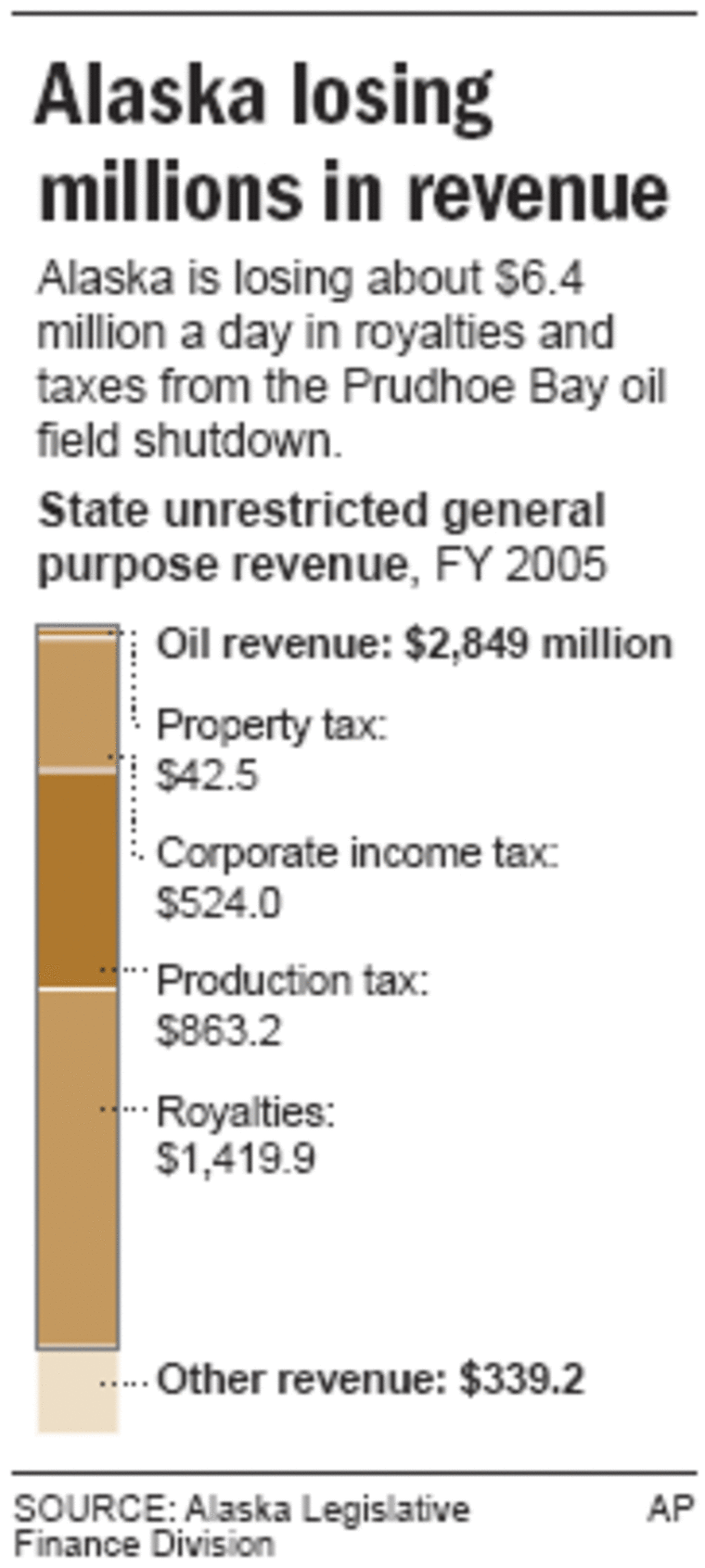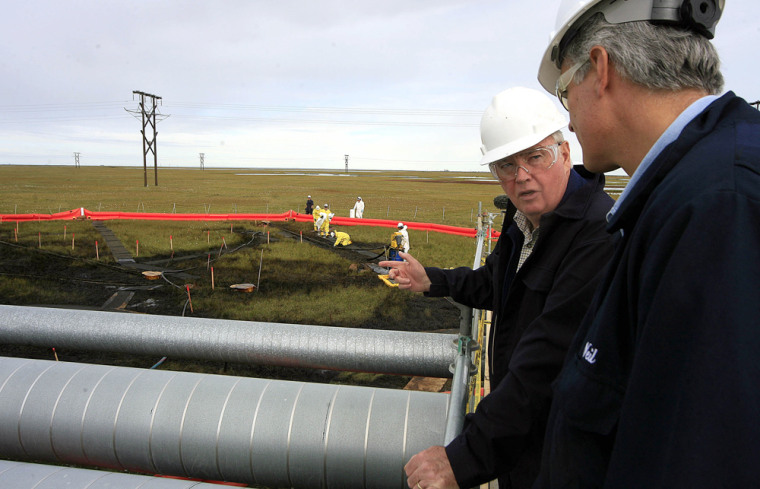BP PLC said Friday it would keep one side of the nation’s largest oil field open as it replaces 16 miles of pipeline, averting a total shutdown that could have put a larger crimp in the nation’s oil supply.
The decision will allow BP to keep funneling up to 200,000 barrels of oil and natural gas from Prudhoe Bay. BP, which operates the oil field, had previously said it would have to completely shut down the field after discovering leaks and severe corrosion on the eastern side of the pipeline nearly a week ago.
The cost to repair and replace leaking pipelines could be about $170 million, the oil giant said earlier on Friday.
Spokesman Neil Chapman said that was an early, rough estimate for the current repairs and for a major oil spill in March. He added that costs could change as the effort continued.
The British company has not yet said exactly how it might divide costs with ConocoPhillips Co. and Exxon Mobil Corp., which also share ownership of the Prudhoe Bay site.
BP, which operates the Alaskan oil field, pledged to replace the pipeline after discovering leaks and severe corrosion in the decades-old pipes nearly a week ago.
The company said it had secured orders for all 16 miles of pipeline it hopes to replace at the oil field, and expects to have the supplies in place by the end of the year.
Repairs could be finished by year’s end
If BP is able to get the new pipeline in place between September and December as planned, it would likely be able to complete the replacement work in early 2007.
Chapman said the pipeline will all come from U.S. steel mills, under contract with companies including United States Steel Corp. The proximity of the steel mills will allow the pipeline to get to Alaska faster.
The company had previously said part of the pipeline would come from Japan’s Nippon Steel Corp., but Chapman said that pipeline would now go for other existing BP projects.
The discovery of leaks and corrosion prompted BP to begin a gradual shut down of the entire oil field, which normally supplies about 400,000 barrels of oil a day. But the company said it decided to continue supplying oil out of the western side of the field after reviewing 1,400 ultrasound inspections on five miles of the pipeline, and discussing the matter with federal and state regulators.
BP said it will monitor the pipeline around the clock and use infrared cameras from the sky and the ground to detect small leaks. It will run a high-tech “smart pig” device through the line by November to search for weaknesses in pipe walls.
“With greatly enhanced surveillance and response capability, I am confident we can continue to safely operate the line,” BP America Chairman and President Bob Malone said in a statement.
The company said it is currently producing about 150,000 barrels of oil and natural gas per day from the western side of the field, but hoped to reach about 200,000 barrels a day.
The natural gas accounts for between 11,000 and 12,000 barrels of the total. Before the discovery of the leaks, BP was pumping as much as 400,000 barrels out of the entire field daily.
BP also said it was looking at ways to restore some production from the eastern side of the field, subject to approval by federal regulators. The company is hoping to complete installation of the new 16 miles of pipeline by early next year.
BP also must pass a series of tests before restarting pipes it shut down.
Pressure to keep oil flowing
Analysts say pressure to keep oil flowing — albeit safely — probably came at BP from several sides, including the state of Alaska, which is highly dependent on the energy industry, and production partners Exxon Mobil and ConocoPhillips, both of whom have bigger stakes in Prudhoe Bay than BP.

“Everybody is watching them,” said Dave Pursell, a former production engineer who worked in the state’s North Slope, now an analyst for Pickering Energy Partners.
“If you keep Prudhoe Bay offline for six months, there is a bigger market impact and gasoline prices will certainly go up,” he said.
On Friday, Exxon Mobil spokeswoman Prem Nair said the company notified customers of its intent to invoke “force majeure.” Such an action alerts customers that it may not be able to supply all the crude oil it has promised because of an unforeseen emergency, and allows them to seek out alternative sources.
“Exxon Mobil has to reduce delivery to our customers and will do so according to provisions in our sales contract,” Nair said.
ConocoPhillips invoked force majeure Thursday. BP has said it has no similar plans because the oil it gets from Prudhoe Bay is processed by the company itself.
Deals continue
The leaks and corrosion that prompted the shutdown were discovered on the eastern side of the oil field, although a much larger spill last March was on the western side.
Even as lawmakers scolded BP for lax maintenance of the Prudhoe Bay pipelines, Alaska Legislature late Thursday nevertheless passed the state’s biggest oil and gas tax law rewrite in decades as a way to spur development of Alaska’s natural gas reserves.
Gov. Frank Murkowski is negotiating a financial deal with the state’s largest oil companies — BP, ConocoPhillips and Exxon Mobil — that is meant to make constructing a $25 billion gas pipeline to Canada attractive.
The three companies negotiating the contract are the state’s largest oil producers, and lease the rights to the North Slope’s gas reserves. The companies would own the pipeline jointly with the state.
The tax bill, which is retroactive to last April once the governor signs it, would set a base tax rate of 22.5 percent of companies’ profits from their Alaska operations. That tax rate would rise by 0.25 percent for every $1 rise in the price of oil above $55 per barrel.
Oil prices have been hovering around $75 a barrel recently.
The companies would be able to claim credits and deductions in the tax bill and use them to partially pay for developing natural gas facilities and infrastructure on the North Slope, which holds about 35 trillion cubic feet of natural gas reserves.
